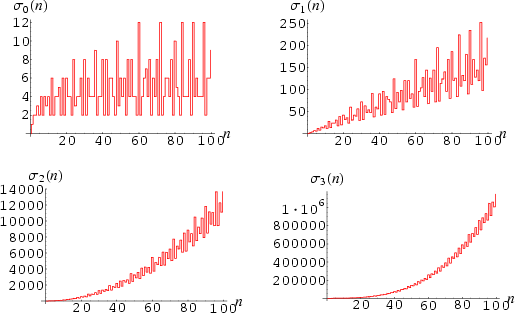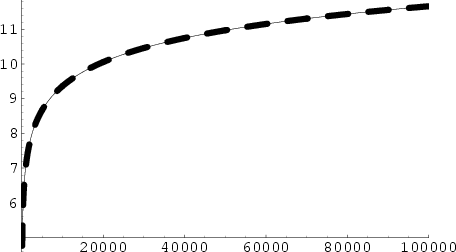
The divisor function ![]() for n an integer is defined as the sum of the kth powers of the (integer) divisors of n,
for n an integer is defined as the sum of the kth powers of the (integer) divisors of n,
| (1) |
It is implemented in Mathematica as DivisorSigma[k, n].
The divisor function can also be generalized to Gaussian integers. The definition requires some care since in principle, there is ambiguity as to which of the four associates is chosen for each divisor. Spira (1961) defines the sum of divisors of a complex number z by factoring z into a product of powers of distinct Gaussian primes,
| (2) |
where ![]() is a unit and each
is a unit and each ![]() lies in the first quadrant of the complex plane, and then writing
lies in the first quadrant of the complex plane, and then writing
| (3) |
This makes ![]() a multiplicative function and also gives
a multiplicative function and also gives ![]() .
.![]() for small nonnegative values of a and b.
for small nonnegative values of a and b.
| 0 | 1 | 2 | 3 | 4 | 5 | 6 | |
| 1 | 1 | ||||||
| 2 | |||||||
| 3 | 4 | ||||||
| 4 | |||||||
| 5 | |||||||
| 6 |
The notations d(n) (Hardy and Wright 1979, p. 239), ![]() (Ore 1988, p. 86), and
(Ore 1988, p. 86), and ![]() (Burton 1989, p. 128) are sometimes used for
(Burton 1989, p. 128) are sometimes used for ![]() ,
,![]() are also given by d(n). The values of
are also given by d(n). The values of ![]() can be found as the inverse Möbius transform of 1, 1, 1, ... (Sloane and Plouffe 1995, p. 22). Heath-Brown (1984) proved that
can be found as the inverse Möbius transform of 1, 1, 1, ... (Sloane and Plouffe 1995, p. 22). Heath-Brown (1984) proved that ![]() infinitely often. The numbers having the incrementally largest number of divisors are called highly composite numbers. The function
infinitely often. The numbers having the incrementally largest number of divisors are called highly composite numbers. The function ![]() satisfies the identities
satisfies the identities
| (4) | |||
| (5) |
where the
The function ![]() that gives the sum of the divisors of n is commonly written without the subscript, i.e.,
that gives the sum of the divisors of n is commonly written without the subscript, i.e., ![]() .
.
As an illustrative example of computing ![]() ,
,![]() ,
,
| (6) | |||
 |
(7) | ||
 |
(8) | ||
 |
(9) |
The following table summarized the first few values of ![]() for small k and n = 1, 2, ....
for small k and n = 1, 2, ....
| k | Sloane | |
| 0 | A000005 | 1, 2, 2, 3, 2, 4, 2, 4, 3, 4, 2, 6, ... |
| 1 | A000203 | 1, 3, 4, 7, 6, 12, 8, 15, 13, 18, ... |
| 2 | A001157 | 1, 5, 10, 21, 26, 50, 50, 85, 91, 130, ... |
| 3 | A001158 | 1, 9, 28, 73, 126, 252, 344, 585, 757, 1134, ... |
The sum of the divisors of n excluding n itself (i.e., the proper divisors of n) is called the restricted divisor function and is denoted s(n). The first few values are 0, 1, 1, 3, 1, 6, 1, 7, 4, 8, 1, 16, ... (Sloane's A001065).
The sum of divisors ![]() can be found as follows. Let
can be found as follows. Let ![]() with
with ![]() and
and ![]() .
.![]() ,
,![]() is a divisor of a and
is a divisor of a and ![]() is a divisor of b. The divisors of a are 1,
is a divisor of b. The divisors of a are 1, ![]() ,
,![]() ,
,![]() ,
,![]() ,
,
| (10) | |||
| (11) |
For a given
| (12) |
Summing over all ![]() ,
,
| (13) |
so ![]() .
.
| (14) |
For a prime power ![]() ,
,![]() ,
,![]() ,
,![]() ,
,
| (15) |
For N, therefore,
 |
(16) |
(Berndt 1985).
For the special case of N a prime, (16) simplifies to
| (17) |
Similarly, for N a power of two, (16) simplifies to
| (18) |
The identities (14) and (16) can be generalized to
| (19) | |||
 |
(20) |
The ![]() function has the series expansion
function has the series expansion
 |
|
 |
(21) |
 |
(22) |
where ![]() is the zeta function and
is the zeta function and ![]() (Wilson 1923), which was used by Ingham in a proof of the prime number theorem (Hardy 1999, pp. 59-60). This gives the special case
(Wilson 1923), which was used by Ingham in a proof of the prime number theorem (Hardy 1999, pp. 59-60). This gives the special case
 |
(23) |
(Hardy 1999, p. 59).
The divisor function also satisfies the inequality
| (24) |
where ![]() is the Euler-Mascheroni constant (Robin 1984, Erdos 1989).
is the Euler-Mascheroni constant (Robin 1984, Erdos 1989).
Gronwall's theorem states that
| (25) |
where ![]() is the Euler-Mascheroni constant (Hardy and Wright 1979, p. 266).
is the Euler-Mascheroni constant (Hardy and Wright 1979, p. 266). ![]() is a power of 2 iff n = 1 or n is a product of distinct Mersenne primes (Sierpinski 1958/59, Sivaramakrishnan 1989, Kaplansky 1999). The first few such n are 1, 3, 7, 21, 31, 93, 127, 217, 381, 651, 889, 2667, ... (Sloane's A046528), and the powers of 2 these correspond to are 0, 2, 3, 5, 5, 7, 7, 8, 9, 10, 10, 12, 12, 13, 14, ... (Sloane's A048947).
is a power of 2 iff n = 1 or n is a product of distinct Mersenne primes (Sierpinski 1958/59, Sivaramakrishnan 1989, Kaplansky 1999). The first few such n are 1, 3, 7, 21, 31, 93, 127, 217, 381, 651, 889, 2667, ... (Sloane's A046528), and the powers of 2 these correspond to are 0, 2, 3, 5, 5, 7, 7, 8, 9, 10, 10, 12, 12, 13, 14, ... (Sloane's A048947).
Curious identities derived using modular form theory are given by
 |
(26) |
 |
(27) |
(Apostol 1997, p. 140), together with
 |
(28) |
 |
(29) |
| |
|
| |
(30) |
The divisor function is odd iff n is a square number or twice a square number. The divisor function satisfies the congruence
| (31) |
for all primes and no composite numbers with the exception of 4, 6, and 22 (Subbarao 1974). The number of divisors d(n) is prime whenever ![]() is (Honsberger 1991). Factorizations of
is (Honsberger 1991). Factorizations of ![]() for prime p are given by Sorli.
for prime p are given by Sorli.

In 1838, Dirichlet ![]() showed that the average number of divisors of all numbers from 1 to n is asymptotic to
showed that the average number of divisors of all numbers from 1 to n is asymptotic to
| (32) |
(Conway and Guy 1996; Hardy 1999, p. 55; Havil 2003, pp. 112-113), as illustrated above, where the thin solid curve plots the actual values and the thick dashed curve plots the asymptotic function. This is related to the Dirichlet divisor problem, which seeks to find the "best" coefficient ![]() in
in
 |
(33) |
(Hardy and Wright 1979, p. 264).
The summatory functions for ![]() with a > 1 are
with a > 1 are
 |
(34) |
For a = 1,
 |
(35) |
(Hardy and Wright 1979, p. 266).
![]()
Dirichlet Divisor Problem, Distinct Prime Factors, Divisor, Divisor Product, Even Divisor Function, Factor, Fermat's Divisor Problem, Greatest Prime Factor, Gronwall's Theorem, Highly Composite Number, Least Prime Factor, Multiply Perfect Number, Odd Divisor Function, Ore's Conjecture, Perfect Number, Prime Factor, Refactorable Number, Restricted Divisor Function, Robin's Theorem, Silverman Constant, Sociable Numbers, Sum of Squares Function, Superabundant Number, Tau Function, Totient Function, Totient Valence Function, Twin Peaks, Unitary Divisor Function
![]()
![]()
Abramowitz, M. and Stegun, I. A. (Eds.). "Divisor Functions." §24.3.3 in Handbook of Mathematical Functions with Formulas, Graphs, and Mathematical Tables, 9th printing. New York: Dover, p. 827, 1972.
Apostol, T. M. Modular Functions and Dirichlet Series in Number Theory, 2nd ed. New York: Springer-Verlag, p. 140, 1997.
Berndt, B. C. Ramanujan's Notebooks: Part I. New York: Springer-Verlag, p. 94, 1985.
Burton, D. M. Elementary Number Theory, 4th ed. Boston, MA: Allyn and Bacon, 1989.
Conway, J. H. and Guy, R. K. The Book of Numbers. New York: Springer-Verlag, pp. 260-261, 1996.
Dickson, L. E. History of the Theory of Numbers, Vol. 1: Divisibility and Primality. New York: Chelsea, pp. 279-325, 1952.
Dirichlet, G. L. "Sur l'usage des séries infinies dans la théorie des nombres." J. reine angew. Math. 18, 259-274, 1838.
Erdos, P. "Ramanujan and I." In Proceedings of the International Ramanujan Centenary Conference Held at Anna University, Madras, Dec. 21, 1987. (Ed. K. Alladi). New York: Springer-Verlag, pp. 1-20, 1989.
Guy, R. K. "Solutions of ![]() ,
,![]() ,
,![]() ,
,![]() .
.
Hardy, G. H. Ramanujan: Twelve Lectures on Subjects Suggested by His Life and Work, 3rd ed. New York: Chelsea, pp. 55 and 141, 1999.
Hardy, G. H. and Weight, E. M. An Introduction to the Theory of Numbers, 5th ed. Oxford, England: Oxford University Press, pp. 354-355, 1979.
Heath-Brown, D. R. "A Parity Problem from Sieve Theory." Mathematika 29, 1-6, 1982.
Heath-Brown, D. R. "The Divisor Function at Consecutive Integers." Mathematika 31, 141-149, 1984.
Honsberger, R. More Mathematical Morsels. Washington, DC: Math. Assoc. Amer., pp. 250-251, 1991.
Kaplansky, I. "The First Two Chapters of Dickson's History." Unpublished manuscript, Apr. 1999.
Nagell, T. Introduction to Number Theory. New York: Wiley, pp. 26-27, 1951.
Ore, Ø. Number Theory and Its History. New York: Dover, 1988.
Robin, G. "Grandes valeurs de la fonction somme des diviseurs et hypothese de Riemann." J. Math. Pures Appl. 63, 187-213, 1984.
Sierpinski, W. "Sur les nombres dont la somme de diviseurs est une puissance du nombre 2." Calcutta Math. Soc. Golden Jubilee Commemoration 1958/59, Part I. Calcutta: Calcutta Math. Soc., pp. 7-9, 1963.
Sloane, N. J. A. Sequences A000005, A000203, A001065, A001157, A001158, A046528, and A048947 in "The On-Line Encyclopedia of Integer Sequences." http://www.research.att.com/~njas/sequences/.
Sloane, N. J. A. and Plouffe, S. The Encyclopedia of Integer Sequences. San Diego, CA: Academic Press, 1995.
Sivaramakrishnan, R. Classical Theory of Arithmetic Functions. New York: Dekker, 1989.
Sorli, R. "Factorization Tables." http://www-staff.maths.uts.edu.au/~rons/fact/fact.htm.
Spira, R. "The Complex Sum of Divisors." Amer. Math. Monthly 68, 120-124, 1961.
Subbarao, M. V. "On Two Congruences for Primality." Pacific J. Math. 52, 261-268, 1974.
Wilson, B. M. "Proofs of Some Formulae Enunciated by Ramanujan." Proc. London Math. Soc. 21, 235-255, 1923.
![]()